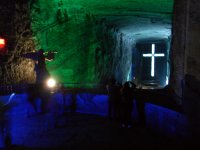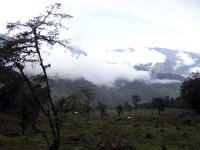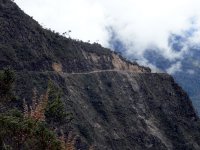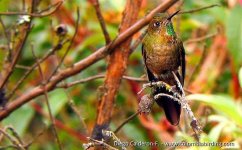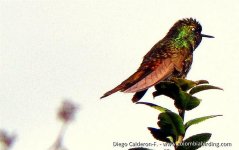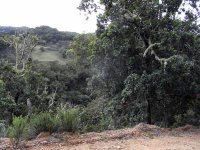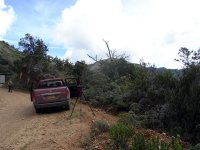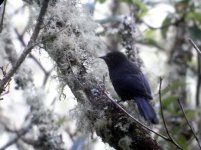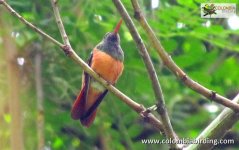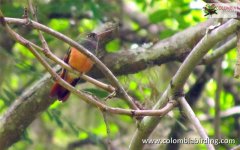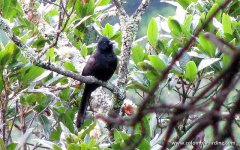antshrike69
Well-known member

Well, actually eleven 
After many years of security issues and access problems, Colombia is finally getting the recognition it deserves amongst birders. In recent years, the government has made enormous progress in the fight against the guerillas and huge areas which were previously unsafe are now easy to visit. The topography is complicated with three separate Andean chains as well as the hulking mass of Santa Marta in the North. Colombia is also the only South American country with both Pacific and Caribbean coastlines. It is hardly surprising then that Colombia has the highest species list in the world, with new discoveries and taxonomic changes increasing this on an annual basis.
I've spent many happy months travelling the country over the years, but given the number of endemics and other specialities there is always more to return for. Many birders follow a similar route giving huge species lists and lots of specials but some of the really good birds require travelling to more off-the-beaten-track parts of the country.
More and more tour companies are now offering Colombian itineraries. For me, however, a more targetted trip was needed. I spoke to several ground agents and finally settled on Ecoturs. This company is linked to Proaves who have worked hard at saving large areas of habitat and establishing many important reserves. Lengthy e-mails between myself and both Trevor Ellery and Robert Giles from Proaves resulted in the final itinerary designed to give me a real chance of some of the rarest birds in South America. Trevor and Robert were both very flexible at tweaking the timings of each site giving a final trip plan I was delighted with and I was very pleased with all aspects of the service Ecoturs provided.
The following links have detailed information on Proaves' work and Ecoturs including much information on the main sites.
http://www.proaves.org/
http://www.ecoturs.org/
Many other companies and organisations in Colombia are also doing fantastic work. The following were very helpful for gen on key species and were invaluable at providing information. Both offer superb set tours or can arrange private trips such as the one I settled on.
http://www.colombiabirding.com/index.php
http://www.manakinnaturetours.com/
So, armed with a three week itinerary, an iPod with 1500+ calls and songs loaded and a variety of field guides, I was ready to return to one of the best birding countries in the world.
After many years of security issues and access problems, Colombia is finally getting the recognition it deserves amongst birders. In recent years, the government has made enormous progress in the fight against the guerillas and huge areas which were previously unsafe are now easy to visit. The topography is complicated with three separate Andean chains as well as the hulking mass of Santa Marta in the North. Colombia is also the only South American country with both Pacific and Caribbean coastlines. It is hardly surprising then that Colombia has the highest species list in the world, with new discoveries and taxonomic changes increasing this on an annual basis.
I've spent many happy months travelling the country over the years, but given the number of endemics and other specialities there is always more to return for. Many birders follow a similar route giving huge species lists and lots of specials but some of the really good birds require travelling to more off-the-beaten-track parts of the country.
More and more tour companies are now offering Colombian itineraries. For me, however, a more targetted trip was needed. I spoke to several ground agents and finally settled on Ecoturs. This company is linked to Proaves who have worked hard at saving large areas of habitat and establishing many important reserves. Lengthy e-mails between myself and both Trevor Ellery and Robert Giles from Proaves resulted in the final itinerary designed to give me a real chance of some of the rarest birds in South America. Trevor and Robert were both very flexible at tweaking the timings of each site giving a final trip plan I was delighted with and I was very pleased with all aspects of the service Ecoturs provided.
The following links have detailed information on Proaves' work and Ecoturs including much information on the main sites.
http://www.proaves.org/
http://www.ecoturs.org/
Many other companies and organisations in Colombia are also doing fantastic work. The following were very helpful for gen on key species and were invaluable at providing information. Both offer superb set tours or can arrange private trips such as the one I settled on.
http://www.colombiabirding.com/index.php
http://www.manakinnaturetours.com/
So, armed with a three week itinerary, an iPod with 1500+ calls and songs loaded and a variety of field guides, I was ready to return to one of the best birding countries in the world.
Last edited:






